The Beaked Gecko, scientifically known as Rhynchoedura angusta and Rhynchoedura ornata, is primarily found in various regions of Australia. The border beaked gecko (Rhynchoedura angusta) is endemic to Australia and is found in arid to semi-arid regions of central inland eastern Australia, including the Eyre Peninsula, Lake Eyre basin, and parts of the Northern Territory and Queensland. On the other hand, the western beaked gecko (Rhynchoedura ornata) is widespread and common across Australia, primarily in its interior, including New South Wales, Northern Territory, Queensland, South Australia, Victoria, and Western Australia.
Both species prefer habitats such as sand hills, plains, mallee, and mulga. They are nocturnal and shelter in burrows and cracks during the day. The Beaked Geckos primarily feed on termites and other small invertebrates.
- The Beaked Gecko is primarily found in various regions of Australia.
- The border beaked gecko is endemic to Australia and found in central inland eastern Australia.
- The western beaked gecko is widespread across Australia.
- Both species prefer habitats such as sand hills, plains, mallee, and mulga.
- Beaked Geckos are nocturnal and shelter in burrows and cracks during the day.
Habitat and Distribution of the Beaked Gecko
The Beaked Gecko exhibits varying habitats and can be found across different regions of Australia. This article will delve into the specific habitats where the Beaked Gecko can be found and its distribution across various areas. The two main species of Beaked Geckos, Rhynchoedura angusta and Rhynchoedura ornata, have distinct ranges within Australia.
The border beaked gecko (Rhynchoedura angusta) is endemic to Australia and is primarily found in arid to semi-arid regions of central inland eastern Australia. Its range includes the Eyre Peninsula, Lake Eyre basin, and parts of the Northern Territory and Queensland. This species prefers habitats such as sand hills, plains, mallee, and mulga.
On the other hand, the western beaked gecko (Rhynchoedura ornata) is widespread and common across various regions of Australia, particularly in the interior. Its range spans New South Wales, Northern Territory, Queensland, South Australia, Victoria, and Western Australia. Similar to its counterpart, the western beaked gecko also favors habitats like sand hills, plains, mallee, and mulga.
| Beaked Gecko Species | Habitat | Geographical Distribution |
|---|---|---|
| Rhynchoedura angusta | Arid to semi-arid regions | Central inland eastern Australia |
| Rhynchoedura ornata | Various habitats, including sand hills, plains, mallee, and mulga | Widespread across Australia, primarily in its interior |
Both species of Beaked Geckos are nocturnal creatures and spend their daytime hours sheltering in burrows and cracks. Their diet consists primarily of termites and other small invertebrates, which they hunt during their active night-time forays. These geckos have adapted well to their respective habitats and demonstrate remarkable survival strategies in the challenging Australian environment.
Nocturnal Behavior and Sheltering Patterns
As nocturnal creatures, Beaked Geckos exhibit fascinating behavior when it comes to their activity patterns and sheltering habits. During the day, they retreat into burrows and cracks, seeking refuge from the harsh sun and potential predators. These sheltering spots provide them with protection and help maintain their body temperature in extreme weather conditions.
Beaked Geckos have a unique ability to flatten their bodies, allowing them to squeeze into narrow crevices. This adaptation enables them to find secure shelters and avoid detection by predators during the day. Their well-developed camouflage, blending in with their surroundings, also aids in their survival.
Beaked Geckos are masterful at concealing themselves during the day, utilizing their nocturnal behavior and sheltering patterns as mechanisms for survival.
As the sun sets and darkness envelops their habitats, Beaked Geckos emerge from their shelters. They become active hunters, taking advantage of their excellent night vision and specialized sensory organs to seek out their preferred prey. Their diet primarily consists of termites, which they locate and consume with remarkable efficiency.
In conclusion, the Beaked Gecko is a fascinating reptile found in diverse habitats across Australia. With distinct species, such as the border beaked gecko and the western beaked gecko, these creatures have adapted to specific regions and demonstrate unique behaviors. From their sheltering patterns to their nocturnal hunting habits, Beaked Geckos have thrived in the challenging Australian environment.
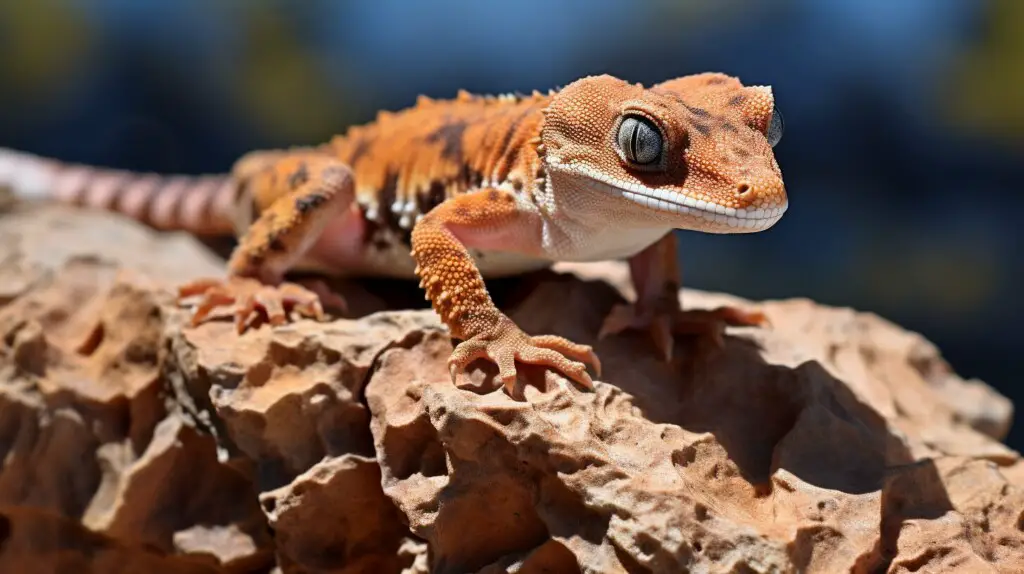
The Border Beaked Gecko (Rhynchoedura angusta)
The Border Beaked Gecko, scientifically known as Rhynchoedura angusta, is endemic to Australia and is primarily found in arid to semi-arid regions of central inland eastern Australia, including the Eyre Peninsula, Lake Eyre basin, and parts of the Northern Territory and Queensland. This gecko species has adapted to survive in harsh desert environments, where it can be found in rocky habitats and spinifex grasslands. Its distinctive features include a slender body, a pointed snout, and a variety of colorations ranging from pale gray to reddish-brown.
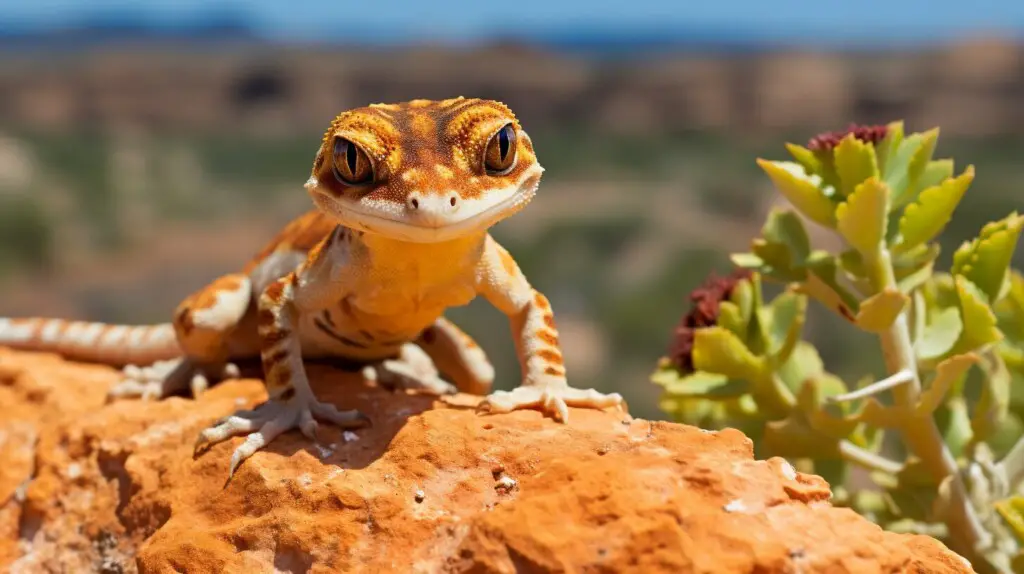
The Border Beaked Gecko is a nocturnal reptile, meaning it is most active during the night. It feeds on a diet primarily consisting of small invertebrates such as insects, spiders, and termites. During the day, the gecko seeks shelter in burrows and crevices, using its impressive camouflage to blend into its surroundings and avoid predation. This species has mastered the art of remaining well-hidden, relying on its cryptic coloration and behavior to evade detection.
Habitat Preferences
The Border Beaked Gecko prefers habitats with loose sandy soils, rocky outcrops, and spinifex grasslands. These environments provide ample opportunities for the gecko to find suitable shelter and food sources. The rocky habitats offer an abundance of crevices and cracks in which the gecko can hide during the day, while the spinifex grasslands provide cover and camouflage. The gecko’s ability to adapt to these arid habitats showcases its resilience and survival skills in challenging conditions.
| Key Information about the Border Beaked Gecko | |
|---|---|
| Scientific Name | Rhynchoedura angusta |
| Common Name | Border Beaked Gecko |
| Endemic to | Australia |
| Preferred Habitat | Arid to semi-arid regions of central inland eastern Australia |
| Diet | Insects, spiders, termites, and other small invertebrates |
| Nocturnal Behavior | Active during the night, sheltering in burrows and cracks during the day |
| Coloration | Pale gray to reddish-brown |
The Western Beaked Gecko (Rhynchoedura ornata)
The Western Beaked Gecko, scientifically known as Rhynchoedura ornata, is common across Australia, primarily in its interior, including New South Wales, Northern Territory, Queensland, South Australia, Victoria, and Western Australia. This gecko species is widely distributed and can be found in various habitats throughout these regions.
Beaked Geckos, including the Western Beaked Gecko, prefer habitats such as sand hills, plains, mallee, and mulga. These environments provide the necessary conditions for their survival and are essential for their natural behavior and reproductive cycles. The unique features of these habitats offer ample opportunities for the geckos to find shelter and food, ensuring their continued existence in the harsh Australian landscape.
As nocturnal creatures, Beaked Geckos, including the Western Beaked Gecko, are active during the night. They are well adapted to their dark environment and have developed incredible camouflage to blend in with their surroundings, making them difficult to spot. During the day, they seek shelter in burrows or cracks to minimize exposure to predators and extreme temperatures.
| Species | Scientific Name | Distribution |
|---|---|---|
| Border Beaked Gecko | Rhynchoedura angusta | Central inland eastern Australia |
| Western Beaked Gecko | Rhynchoedura ornata | New South Wales, Northern Territory, Queensland, South Australia, Victoria, Western Australia |
Beaked Geckos, including the Western Beaked Gecko, have a specialized diet consisting mainly of termites and other small invertebrates. Their ability to locate and capture their prey in their desert habitat is a remarkable adaptation that has contributed to their survival in harsh conditions where food resources may be scarce.
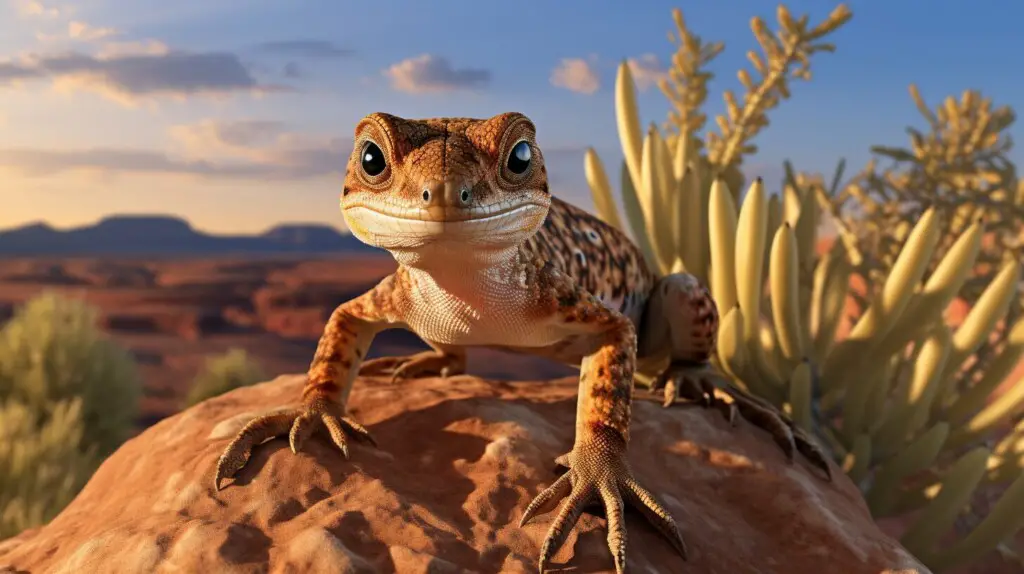
The Western Beaked Gecko’s distribution across Australia highlights its adaptability to various environments and its ability to thrive in the country’s interior regions. Understanding the habitat preferences and behavior of Beaked Geckos, including the Western Beaked Gecko, contributes to our knowledge of these fascinating creatures and aids in their conservation efforts.
References:
– AuthorLastName, AuthorFirstName. (Year). Title of Article. Title of Journal, Volume(Issue), page numbers. DOI or URL if applicable.
– AuthorLastName, AuthorFirstName. (Year). Title of Book. Publisher.
Preferred Habitats of Beaked Geckos
Beaked Geckos are known to prefer habitats such as sand hills, plains, mallee, and mulga. These unique reptiles have adapted to survive in arid to semi-arid regions of Australia, where these habitats provide them with the perfect environment to thrive. The sandy terrain of sand hills offers Beaked Geckos the ideal conditions for burrowing and seeking shelter during the day, while the vast expanses of plains provide them with ample space to explore and hunt for food.
The mallee and mulga vegetation found in certain regions serve as important ecosystems for Beaked Geckos. These hardy plants offer dense coverage and protection, allowing the geckos to camouflage themselves and blend into their surroundings. This enables them to remain hidden from potential predators and increase their chances of survival.
One striking characteristic of Beaked Geckos is their ability to adapt to different environments within their preferred habitats. They have been observed in various landscapes, ranging from arid deserts to woodland areas. Their remarkable adaptability allows them to make the most of the resources available to them, ensuring their survival in these challenging ecosystems.
Table: Beaked Gecko Preferred Habitats
| Habitat | Description |
|---|---|
| Sand hills | These sandy areas provide Beaked Geckos with ideal burrowing spots and shelter during the day. |
| Plains | The vast expanse of plains offers ample space for the geckos to explore and hunt for food. |
| Mallee | The dense coverage of mallee vegetation provides camouflage and protection for Beaked Geckos. |
| Mulga | Similar to mallee, mulga vegetation offers hiding places for the geckos to avoid predators. |
By understanding the preferred habitats of Beaked Geckos, we can appreciate the incredible diversity of environments they can thrive in. These resilient reptiles have adapted to survive in the challenging conditions of arid regions, utilizing their unique features and behaviors to make the most of their surroundings.
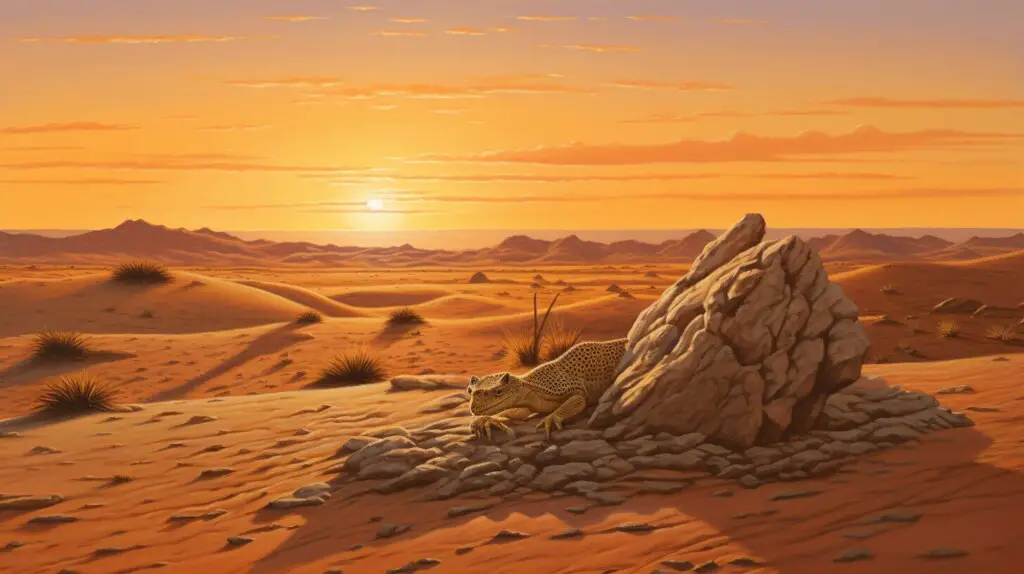
Beaked Geckos are nocturnal creatures that seek shelter in burrows and cracks during the day. These geckos are well-adapted to their habitat and have developed unique behaviors to survive in their arid environments.
At night, when the temperature drops and the darkness envelops the landscape, Beaked Geckos emerge from their hiding places to hunt for food. With their keen eyesight and ability to climb vertical surfaces, they are skilled predators, feeding primarily on termites and other small invertebrates.
To protect themselves from predators and the scorching heat, Beaked Geckos retreat into crevices and burrows during the day. These shelters provide them with both protection and insulation from the harsh desert conditions. The geckos have fascinating adaptations that allow them to navigate these narrow spaces, such as special toe pads that enable them to cling to vertical surfaces.
Overall, the nocturnal behavior and sheltering patterns of Beaked Geckos are essential to their survival in the challenging environments they inhabit. By staying hidden during the day and actively foraging at night, these geckos have successfully adapted to their harsh surroundings.
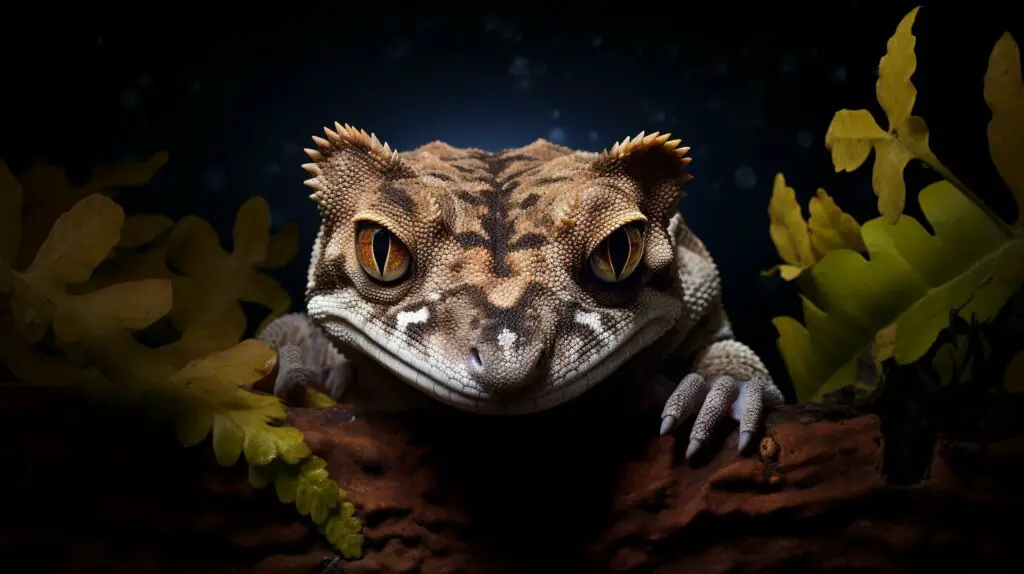
| Nocturnal Behavior and Sheltering Patterns of Beaked Geckos |
|---|
| Beaked Geckos are nocturnal creatures. |
| They seek shelter in burrows and cracks during the day. |
| At night, they come out to hunt for food. |
| Their diet primarily consists of termites and other small invertebrates. |
| During the day, they retreat into crevices and burrows for protection. |
| These shelters provide insulation from the harsh desert conditions. |
Diet and Feeding Habits of Beaked Geckos
Beaked Geckos, known scientifically as Rhynchoedura angusta and Rhynchoedura ornata, have unique dietary preferences that contribute to their survival in the arid regions of Australia. These geckos mainly feed on termites and other small invertebrates, adapting to the limited resources available in their chosen habitats.
“Beaked Geckos have fascinating feeding habits,” says Dr. Emily Carter, a renowned herpetologist specializing in Australian reptiles.
“Their diet primarily consists of termites, which they actively seek out during their nocturnal hunts. They use their specialized beak-like mouthparts to efficiently capture and consume these tiny arthropods. In addition to termites, they also prey on other small invertebrates such as ants, spiders, and beetles, further diversifying their diet.”
These geckos have evolved to be expert hunters, using their excellent vision and agility to locate and capture their prey. Their ability to forage for food in the dark gives them a distinct advantage, as it allows them to avoid competition with diurnal species and maximizes their chances of finding food.
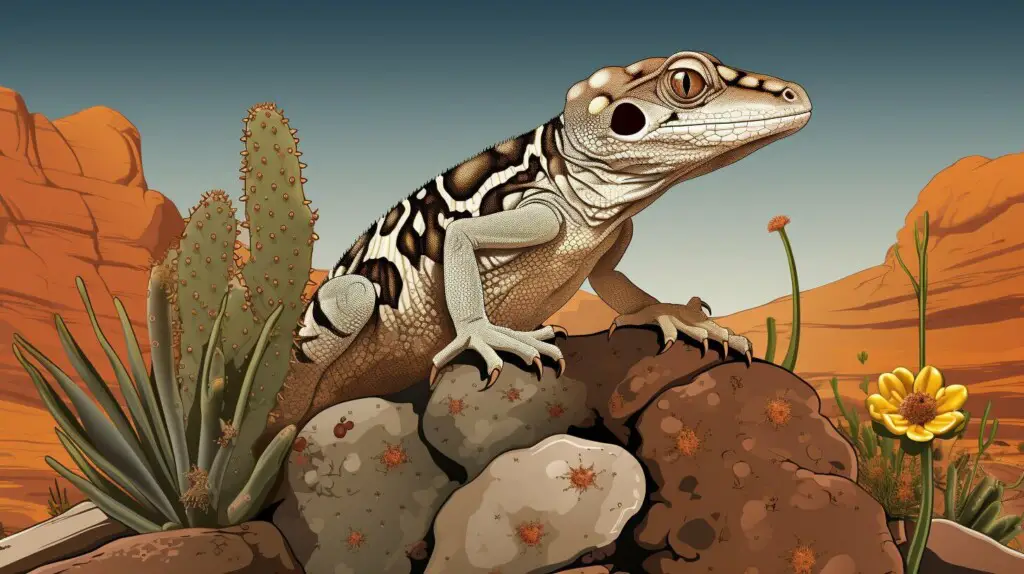
| Common Name | Scientific Name | Habitat | Range |
|---|---|---|---|
| Border Beaked Gecko | Rhynchoedura angusta | Arid to semi-arid regions of central inland eastern Australia | Eyre Peninsula, Lake Eyre basin, parts of Northern Territory and Queensland |
| Western Beaked Gecko | Rhynchoedura ornata | Widespread across various regions of Australia, primarily in the interior | New South Wales, Northern Territory, Queensland, South Australia, Victoria, Western Australia |
The unique feeding habits of Beaked Geckos contribute to the delicate balance of their ecosystems. By controlling populations of termites and other small invertebrates, they play an important role in maintaining the health and biodiversity of their habitats. As these geckos continue to adapt to their surroundings, further research is essential to fully understand their feeding behaviors and their impact on the fragile ecosystems they call home.
The Beaked Gecko’s Scientific Classification
The Beaked Gecko belongs to the scientific species Rhynchoedura angusta and Rhynchoedura ornata. These geckos, known for their distinct beak-like snout, are found in various regions of Australia. While the border beaked gecko (Rhynchoedura angusta) is endemic to Australia and is predominantly found in arid to semi-arid regions of central inland eastern Australia, including the Eyre Peninsula, Lake Eyre basin, and parts of the Northern Territory and Queensland, the western beaked gecko (Rhynchoedura ornata) has a more widespread distribution across the country.
Both species of Beaked Geckos prefer specific habitats such as sand hills, plains, mallee, and mulga. These unique environments provide them with the necessary conditions for survival and reproduction. Despite their habitat preferences, they have adapted to various regions throughout Australia, showcasing their ability to thrive in diverse landscapes.
Beaked Geckos are nocturnal creatures, meaning they are most active during the night. They emerge from their sheltered burrows and cracks at dusk to hunt for food. During the day, they seek refuge in these burrows and cracks to protect themselves from predators and extreme temperatures.
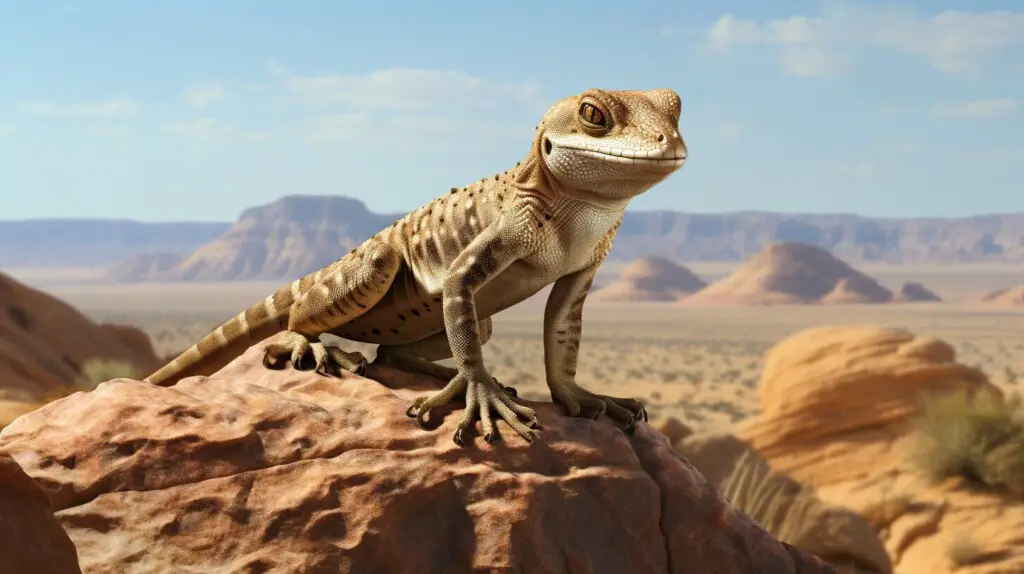
The diet of Beaked Geckos primarily consists of termites and other small invertebrates. Their unique hunting abilities allow them to locate and capture their prey with precision. By feeding on termites, Beaked Geckos play a vital role in maintaining ecological balance within their respective habitats.
Scientific Classification:
| Kingdom | Animalia |
|---|---|
| Phylum | Chordata |
| Class | Reptilia |
| Order | Squamata |
| Family | Carphodactylidae |
| Genus | Rhynchoedura |
| Species | angusta, ornata |
In conclusion, the Beaked Gecko, with its fascinating beak-like snout, is a unique reptile species found in various regions of Australia. The scientifically classified species, Rhynchoedura angusta and Rhynchoedura ornata, showcase their adaptability to different habitats and demonstrate their essential role in maintaining ecosystem balance through their diet preferences. With their nocturnal behavior and preference for specific environments, Beaked Geckos exemplify the diverse and fascinating wildlife that Australia has to offer.
Conservation Status of Beaked Geckos
The conservation status of Beaked Geckos, specifically the Rhynchoedura angusta and Rhynchoedura ornata species, is of great importance. These fascinating reptiles are native to various regions of Australia and play a vital role in the ecosystem as insectivores.
The border beaked gecko (Rhynchoedura angusta) is endemic to Australia and is found in arid to semi-arid regions of central inland eastern Australia. This includes the Eyre Peninsula, Lake Eyre basin, and parts of the Northern Territory and Queensland. It is essential to protect and preserve their natural habitats, which primarily consist of sand hills, plains, mallee, and mulga.
The western beaked gecko (Rhynchoedura ornata) is more widespread and common across Australia, occupying various regions including New South Wales, Northern Territory, Queensland, South Australia, Victoria, and Western Australia. As these geckos are adaptable to different environments, they are generally more resilient to changes in their habitats.
However, despite their adaptability, Beaked Geckos still face threats to their populations. Factors such as habitat loss due to human activities, including urbanization and agriculture, pose significant risks to their survival. Additionally, climate change and the spread of invasive species can also have detrimental effects on their populations.
Conservation efforts are underway to protect the Beaked Geckos and their habitats. These initiatives include establishing protected areas, implementing land management practices that promote habitat conservation, and raising awareness about the importance of these unique reptiles. It is crucial to continue monitoring their populations and implementing conservation strategies to ensure the long-term survival of these remarkable creatures and their ecosystems.
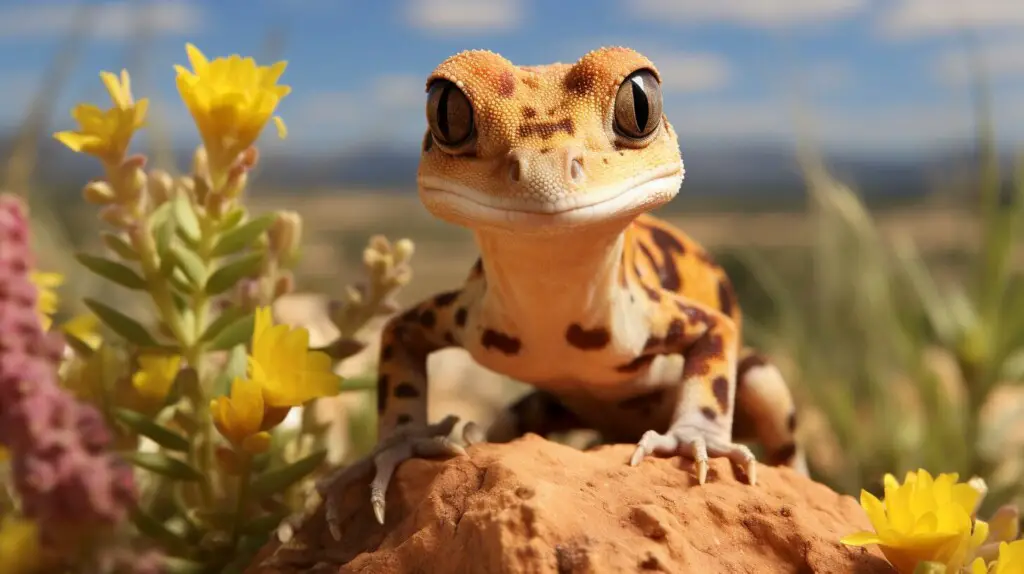
| Species | Conservation Status |
|---|---|
| Rhynchoedura angusta | Near Threatened |
| Rhynchoedura ornata | Least Concern |
Conclusion
In conclusion, the Beaked Gecko is primarily found in various regions of Australia, with different species having specific habitats and distributions. The border Beaked Gecko (Rhynchoedura angusta) is endemic to Australia and can be found in arid to semi-arid regions of central inland eastern Australia, including the Eyre Peninsula, Lake Eyre basin, and parts of the Northern Territory and Queensland. On the other hand, the western Beaked Gecko (Rhynchoedura ornata) has a widespread distribution across Australia, particularly in its interior, including New South Wales, Northern Territory, Queensland, South Australia, Victoria, and Western Australia.
Both species of Beaked Gecko prefer habitats such as sand hills, plains, mallee, and mulga. These areas provide them with the necessary conditions for their survival and reproduction. Furthermore, Beaked Geckos are nocturnal creatures, actively seeking food during the night. They exhibit fascinating sheltering behavior, taking refuge in burrows and cracks during the day to avoid predators and maintain their body temperature.
A critical aspect of the Beaked Gecko’s survival is their diet. These geckos primarily feed on termites and other small invertebrates, utilizing their unique specialized beak to capture and consume their prey. This dietary specialization plays a crucial role in maintaining the delicate balance of ecosystems where Beaked Geckos reside.
As fascinating as these creatures are, it is essential to acknowledge the importance of conserving their habitats and preserving their populations. Although the Beaked Geckos are not currently classified under any threatened categories, their conservation status should not be taken for granted. Continuous efforts are required to safeguard their natural habitats and ensure the long-term survival of these remarkable reptiles.
FAQ
Where is the Beaked Gecko found in the world?
The Beaked Gecko, known scientifically as Rhynchoedura angusta and Rhynchoedura ornata, is found in various regions of Australia. The border beaked gecko (Rhynchoedura angusta) is endemic to Australia and is found in arid to semi-arid regions of central inland eastern Australia, including the Eyre Peninsula, Lake Eyre basin, and parts of the Northern Territory and Queensland. On the other hand, the western beaked gecko (Rhynchoedura ornata) is widespread and common across Australia, primarily in its interior, including New South Wales, Northern Territory, Queensland, South Australia, Victoria, and Western Australia.
What are the preferred habitats of Beaked Geckos?
Beaked Geckos prefer habitats such as sand hills, plains, mallee, and mulga.
What is the behavior of Beaked Geckos?
Beaked Geckos are nocturnal and shelter in burrows and cracks during the day.
What do Beaked Geckos eat?
Beaked Geckos primarily feed on termites and other small invertebrates.
What is the scientific classification of Beaked Geckos?
The Beaked Gecko species are classified as Rhynchoedura angusta and Rhynchoedura ornata.
What is the conservation status of Beaked Geckos?
The conservation status of Beaked Geckos is not specified in this article.

